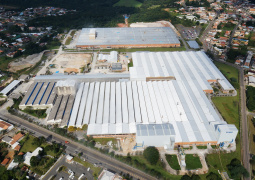Incepa Responds: types of finishing

In other blog posts, we explain in detail the difference between ceramic and porcelain wall tiles, covering aspects related to the mechanical strength and porosity of each one of them.
However, to put you in context on the topic – and ensure that you understand the content of this text very well – we will do a brief review. Porcelain wall tile is a ceramic product that, already in its manufacturing process, differs from conventional ceramic wall tile.
For their manufacture, refined materials and porcelain are subjected to a very high firing temperature, which guarantees pieces with more mechanical strength and low porosity.
The factor that determines these two characteristics is the porosity of the mass: the more porous a wall tile, the more water it absorbs and the less resistant it will be. Porcelain wall tiles are the wall tiles that absorb less water, with an index that varies between 0.1% and 0.5%, hence their high resistance.
Now that you have more information about wall tile and resistance, it’s time to talk about a subject that confuses even specialized professionals: finishing. There are a multitude of finishes and each of them has a specific function.
In addition to complementing the aesthetics of the environment, they are the key piece to ensuring a safe space for people. In this following text, we have gathered some models and indications on which type of finish should be used in different types of environments. Check out!
Wet Friction Coefficient
Before we talk about finishes, it’s important to keep in mind what coefficient of friction means. Briefly, we can say that it corresponds to the measure that characterizes a surface regarding the ease (or not) of slipping.
According to the product standard, wall tiles for indoor areas can have a coefficient of friction <0.40, while those for outdoor areas should have a coefficient of friction ≥0.40, as these locations require more slip resistance.
The performance standard classifies these areas into:
- Wet: where water slides can form, such as bathrooms with showers and service areas.
- Wettable: Areas where splashes can occur, such as bathrooms without showers, kitchens, and covered balconies.
- Dry: spaces not directly exposed to water – not even during cleaning.
To meet market requirements and the standards mentioned above, Roca Brasil Cerámica has developed products with different levels of slip resistance:
Grip
It has a Wet Friction Coefficient of 0.40 to 0.49, making it ideal for indoor wet areas. In addition, it has a less rough surface and a smoother touch, when compared to conventional non-slip tiles. These features also make it very easy to clean.

Grip Plus
Its Coefficient of Wet Friction is between 0.50 and 0.69. Therefore, we recommend using it on residential sidewalks, indoor stairs and balconies. In addition, its surface is smoother when compared to ABS, making it practical for daily cleaning.
Incepa will have many new features in 2021, including products with Grip Plus finish. Stay tuned!
ABS
The ABS finish has a Wet Friction Coefficient > 0.70, which guarantees a product with 30% greater adhesion than other traditional finishes. For this reason, the material is a suitable choice for wet areas where slip resistance is critical (pool decks, outdoor stairs, and ramps with up to a 10% slope, etc.).
Another characteristic of the material is that, despite the high index of Moist Friction Coefficient, its surface is not as rough when compared to natural stones or conventional non-slip wall tiles, thus facilitating the maintenance of practicality in clean.
This is the result of Roca Brasil Cerámica’s exclusive grit, which provides several benefits. As we can see in the images below:
The Quartzite wall tile is one of Incepa’s products that has also an ABS wall tile. In the project below it was not used in external areas, showing its versatility.

Cleanability and stain resistance
In the finishes above, we mentioned the ease of cleaning of each of them. This characteristic is determined by the degree of cleanability and stain resistance.
In enameled pieces, this is directly linked to the surface texture. The non-enameled ones depend on the porosity of the mass. However, in general, we can say that products with a smooth texture are easier to maintain than those with a rough texture.
The vast majority of Roca Brasil Cerámica ceramic wall tiles are easy to clean and are easily cleaned with household products.
With this content, we hope you have understood the difference between the types of finishes and can make the best possible choice according to the environment. Remembering that these are the finishes related to slip resistance, a safety attribute. However, there are other types of finishes related to porcelain. You can learn more about them in our next post.





